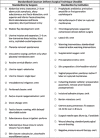The Case for Standardizing Cesarean Delivery Technique: Seeing the Forest for the Trees
- PMID: 33030865
- PMCID: PMC7575029
- DOI: 10.1097/AOG.0000000000004120
The Case for Standardizing Cesarean Delivery Technique: Seeing the Forest for the Trees
Abstract
In this Commentary, we explain the case for a standardized cesarean delivery surgical technique. There are three strong arguments for a standardized approach to cesarean delivery, the most common major abdominal surgery performed in the world. First, standardization within institutions improves safety, efficiency, and effectiveness in health care delivery. Second, surgical training among obstetrics and gynecology residents would become more consistent across hospitals and regions, and proficiency in performing cesarean delivery measurable. Finally, standardization would strengthen future trials of cesarean delivery technique by minimizing the potential for aspects of the surgery which are not being studied to bias results. Before 2013, more than 155 randomized controlled trials, meta-analyses or systematic reviews were published comparing various aspects of cesarean delivery surgical technique. Since 2013, an additional 216 similar studies have strengthened those recommendations and offered evidence to recommend additional cesarean delivery techniques. However, this amount of cesarean delivery technique data creates a forest for the trees problem, making it difficult for a clinician to synthesize this volume of data. In response to this difficulty, we propose a comprehensive, evidence-based and standardized approach to cesarean delivery technique.
Figures
Similar articles
-
Guidelines for Antenatal and Preoperative care in Cesarean Delivery: Enhanced Recovery After Surgery Society Recommendations (Part 1).Am J Obstet Gynecol. 2018 Dec;219(6):523.e1-523.e15. doi: 10.1016/j.ajog.2018.09.015. Epub 2018 Sep 18. Am J Obstet Gynecol. 2018. PMID: 30240657
-
Guidelines for intraoperative care in cesarean delivery: Enhanced Recovery After Surgery Society Recommendations (Part 2).Am J Obstet Gynecol. 2018 Dec;219(6):533-544. doi: 10.1016/j.ajog.2018.08.006. Epub 2018 Aug 15. Am J Obstet Gynecol. 2018. PMID: 30118692
-
Danish obstetricians' personal preference and general attitude to elective cesarean section on maternal request: a nation-wide postal survey.Acta Obstet Gynecol Scand. 2004 Mar;83(3):262-6. doi: 10.1111/j.0001-6349.2004.0312.x. Acta Obstet Gynecol Scand. 2004. PMID: 14995922
-
[Changing trends and indications for cesarean section in the last few decades].Orv Hetil. 2014 Jul 20;155(29):1140-6. doi: 10.1556/OH.2014.29931. Orv Hetil. 2014. PMID: 25016445 Review. Hungarian.
-
Evidence-based surgery for cesarean delivery.Am J Obstet Gynecol. 2005 Nov;193(5):1607-17. doi: 10.1016/j.ajog.2005.03.063. Am J Obstet Gynecol. 2005. PMID: 16260200 Review.
Cited by
-
Horizontal mattress uterine closure compared to single layered lock suture in cesarean section - A retrospective cohort study.Eur J Obstet Gynecol Reprod Biol X. 2023 Sep 3;20:100234. doi: 10.1016/j.eurox.2023.100234. eCollection 2023 Dec. Eur J Obstet Gynecol Reprod Biol X. 2023. PMID: 37701631 Free PMC article.
-
Impact of Intraoperative Factors on the Development of Postpartum Septic Complications.Medicina (Kaunas). 2023 Sep 10;59(9):1637. doi: 10.3390/medicina59091637. Medicina (Kaunas). 2023. PMID: 37763756 Free PMC article.
-
Is cesarean scar defect becoming history? The effect of uterotomy closure.Rev Assoc Med Bras (1992). 2025 May 2;71(3):e20241507. doi: 10.1590/1806-9282.20241507. eCollection 2025. Rev Assoc Med Bras (1992). 2025. PMID: 40332264 Free PMC article. Clinical Trial.
-
Cesarean delivery surgical techniques in Africa: A survey study from Ethiopia.PLoS One. 2023 Oct 9;18(10):e0292382. doi: 10.1371/journal.pone.0292382. eCollection 2023. PLoS One. 2023. PMID: 37812627 Free PMC article.
-
Evidence-based surgical procedures to optimize caesarean outcomes: an overview of systematic reviews.EClinicalMedicine. 2024 May 19;72:102632. doi: 10.1016/j.eclinm.2024.102632. eCollection 2024 Jun. EClinicalMedicine. 2024. PMID: 38812964 Free PMC article. Review.
References
-
- Boerma T, Ronsmans C, Melesse DY, Barros AJD, Barros FC, Juan L, et al. Global epidemiology of use of and disparities in caesarean sections. Lancet 2018;392:1341–8. - PubMed
-
- Hamilton BE, Martin JA, Osterman MJK. Births: provisional data for 2019. Vital Statistics Rapid Release; no 8. Available at: https://www.cdc.gov/nchs/data/vsrr/vsrr-8-508.pdf. Retrieved May 21, 2020.
-
- Berghella V, Baxter JK, Chauhan SP. Evidence-based surgery for cesarean delivery. Am J Obstet Gynecol 2005;193:1607–17. - PubMed
-
- Dahlke JD, Mendez-Figueroa H, Rouse DJ, Berghella V, Baxter JK, Chauhan SP. Evidence-based surgery for cesarean delivery: an updated systematic review. Am J Obstet Gynecol 2013;209:294–306. - PubMed
-
- Clinical guidelines and standardization of practice to improve outcomes. ACOG Committee Opinion No. 792. American College of Obstetricians and Gynecologists. Obstet Gynecol 2019;134:e122–5. - PubMed
MeSH terms
LinkOut - more resources
Full Text Sources
Medical


